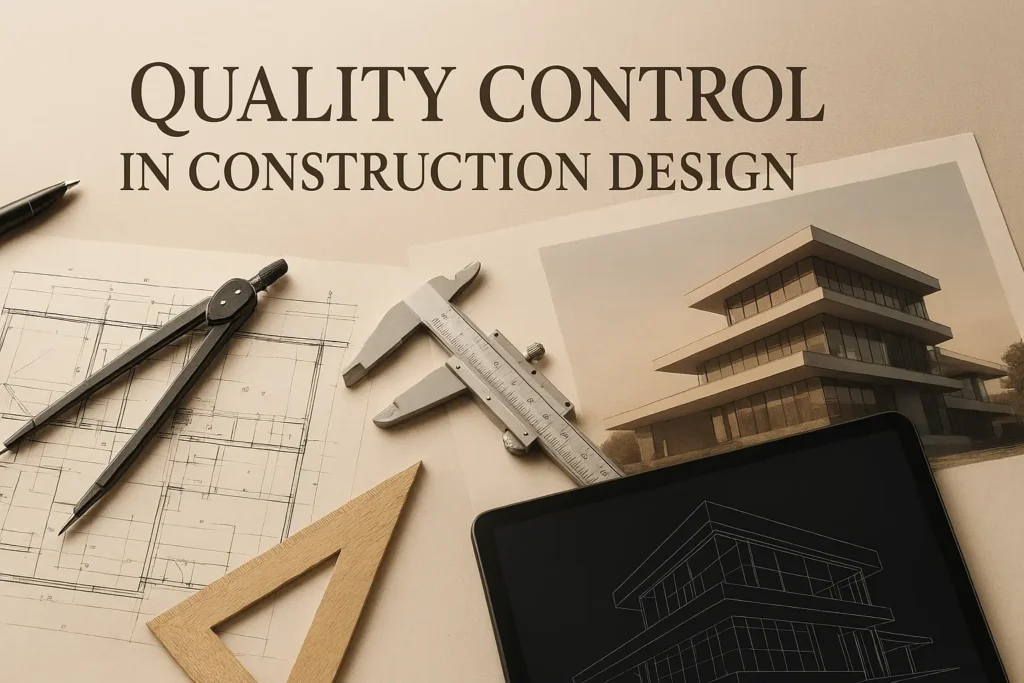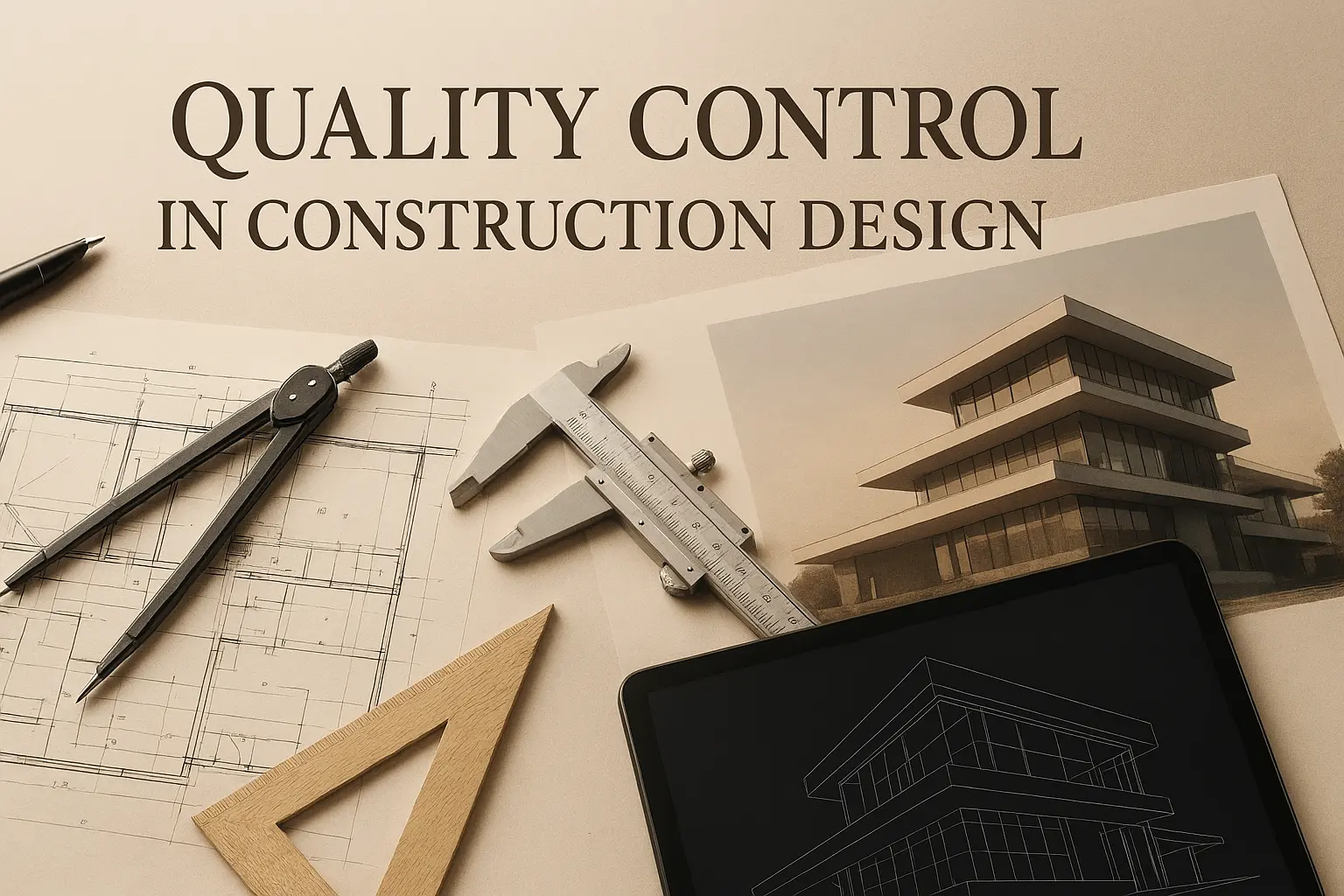Table of Contents
ToggleUnderstanding the Role of Quality Control in Construction Design
In the complex world of construction, precision is everything. Each project—whether a residential development, commercial tower, or renovation—depends on how effectively teams manage quality from the design phase onward. Quality control in construction determines whether you deliver accurate, buildable, and code‑compliant documentation or face rework, delays, and added costs later.
For General Contractors (GCs) and Quality Assurance (QA) teams, consistent design quality isn’t optional—it’s a foundation of trust. At Design Sync Studio, we help professionals maintain accuracy across every design stage through advanced coordination, digital modeling, and documentation reviews that match North American building standards.
What Is Quality Control in Construction?
Quality control (QC) in construction refers to the systematic review and verification of design documents, models, and specifications to ensure they meet project criteria and regulatory codes. It’s an integrated method that connects creative design intent to technical constructability. Without structured QC, even the best architectural ideas can face expensive field challenges.
QC involves process discipline—checking, comparing, documenting, and communicating. It ensures that drawings are clear, coordinated, and practical, so that contractors, engineers, and inspectors all interpret them the same way.
Major Components of Effective QC in Construction Design
1. Architectural Accuracy and Coordination
Every successful project begins with a strong architectural foundation. Overlapping grids, misaligned walls, or incorrect slab elevations can quickly escalate costs. Our Architectural Design experts use layered quality‑control checklists, combining 2D and 3D review stages, to confirm that every drawing is dimensionally precise and aligned with the structural and MEP systems.
2. BIM Integration and Clash Detection
In modern workflows, BIM (Building Information Modeling) is the ultimate bridge for design accuracy. With our advanced BIM Services, we model every component digitally before construction begins, ensuring that pipes don’t cut through beams and light fixtures align perfectly with ceiling grids. Proper BIM‑based clash detection minimizes rework and builds confidence between architects and field teams.
3. Documentation and Version Control
Each project can go through multiple revisions over months or years. Maintaining version control prevents teams from using outdated drawings. Through 2D & 3D Floor Plan Design reviews, we label all deliverables with revision histories and maintain digital records for accountability—critical during audits and project post‑mortems.
4. Compliance and Permit Accuracy
Before a single wall goes up, design documentation must satisfy local and national building codes. Missing minor compliance details can delay permits and inspections. Our Permit Expediting Services streamline coordination with authorities, ensuring submissions are clear, code‑compliant, and accepted the first time.
5. Cost Alignment and Construction Feasibility
Quality design must also align with financial reality. Accurate Project Estimates predict material quantities and labor costs precisely. Our QC teams cross‑check design data against cost projections, ensuring your budget remains stable from design to build.
6. Interior Detailing and Aesthetic Precision
Quality doesn’t stop at the façade. Finishes, joinery, and lighting layouts require detailed quality checks to achieve the intended spatial experience. Partnering with our Interior Design specialists ensures each surface and fixture fits both visually and technically within the design intent.

The Step‑by‑Step Workflow for Quality Control
- Initiate the Quality Plan: Define the project objectives, QA/QC responsibilities, and documentation procedures during kickoff.
- Design Review Scheduling: Establish fixed review intervals (concept, schematic, design development, and permit stages).
- Multidisciplinary Coordination: Architects, engineers, and modelers collaborate using shared BIM models to find inconsistencies early.
- Document Verification: Each sheet is reviewed for dimension accuracy, annotation clarity, and code notes.
- Peer Review: An independent specialist assesses the package objectively to catch overlooked details.
- Corrective Actions: Recorded issues are resolved, reviewed again, and logged for traceability.
- Final Approval: Deliverables are locked and archived redundantly, ensuring all data aligns with final submission standards.
At Design Sync Studio, this quality loop is part of every project we deliver. Each phase builds accountability into the design process, safeguarding clients against coordination gaps and construction delays.
How Technology Strengthens QC in Construction
Emerging technology has transformed how the industry manages quality. Cloud‑based document platforms enable real‑time version control, issue tracking, and digital sign‑offs. BIM workflows integrate architectural, structural, and MEP systems into one environment, offering instant visibility of clashes before anyone steps on site.
Artificial intelligence is also entering the field—automated drawing comparison tools can flag inconsistencies between sheets in seconds. This combination of manual review and smart automation creates a hybrid workflow where speed meets precision. For QA managers, that means higher productivity with fewer human errors.
The Impact of Quality Control on Construction Outcomes
A project with strong QC measures will always outperform one that treats quality as an afterthought. Fewer RFIs (Requests for Information), less rework, faster permits, and greater client satisfaction are the hallmarks of effective control. Conversely, weak quality oversight risks cost overruns, schedule extensions, and even safety violations.
Quality control also boosts a firm’s reputation. In today’s digital marketplace, contractors and architects compete on reliability as much as design creativity. Delivering consistent, error‑free documentation positions your team as a trusted partner, which leads to repeat business and long‑term growth.
Need Reliable QC for Your Next Construction Project?
Our integrated QA and design documentation teams ensure your drawings pass every compliance check and are construction‑ready from day one.
Best Practices for Sustaining Design Quality
- Standardize documentation templates: Consistency accelerates reviews and reduces human error.
- Use BIM coordination as default: Always integrate structural and MEP systems within a shared model.
- Train teams regularly: Continuous code education keeps your designers compliant with evolving regulations.
- Record lessons learned: Every project should contribute to a knowledge base that improves the next deliverable.
- Promote transparent communication: Encourage open feedback between GCs, consultants, and design teams to resolve conflicts early.
Why Partner with Design Sync Studio?
Our multidisciplinary approach merges creativity with engineering logic. By combining design excellence and technological expertise, we ensure that every model, drawing, and specification supports practical construction execution.
Located across Philadelphia (PA) and Maple (ON), we support clients across the U.S. and Canada. Our team follows strict data retention policies, ISO‑aligned QA checklists, and transparent workflows—giving clients full visibility at every milestone. When you work with Design Sync Studio, you get a partner committed to accuracy, accountability, and architectural integrity.
FAQs About Quality Control in Construction Design
1. What is the ultimate purpose of QC in design?
The goal is to produce documentation that’s construction‑ready—accurate, conflict‑free, and compliant—before mobilizing on site.
2. How does BIM contribute to QC efficiency?
BIM centralizes data in one shared model, enabling smarter clash detection and real‑time collaboration among architects, engineers, and contractors.
3. Can QC reduce permitting delays?
Yes. Thorough pre‑checks and properly coordinated drawings lead to faster approval during permit expediting, avoiding rejections caused by incomplete submissions.
4. When should a project’s QC plan start?
Ideally at project inception—before schematic design—so quality metrics are part of the workflow, not an afterthought.
5. Why choose Design Sync Studio for QC support?
Our multidisciplinary professionals combine architectural design, BIM coordination, estimating, and permit experience into one seamless support system, delivering precise and dependable documentation every time.
Final Thoughts
Quality control in construction design shapes the entire project lifecycle—from concept to completion. By embedding structured review systems, leveraging technology, and working with trusted partners like Design Sync Studio, GCs and QA teams can eliminate uncertainty, minimize risk, and deliver projects that reflect excellence in every detail.


